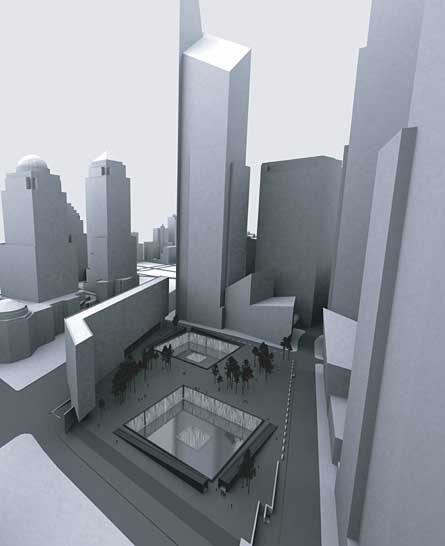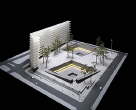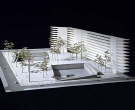|

Reflecting Absence
Michael Arad, New York, NY
This design proposes a space that resonates with the feelings of loss and absence that were generated
by the death and destruction at the World Trade Center. A pair of reflective pools marks the location of the towers' footprints. The surface of these pools is broken by large voids. These voids can be read as
containers of loss, being close-by yet inaccessible.
The pools are submerged thirty feet below street level in the middle of a large open plaza. They too are
large voids, open and visible reminders of the absence. The pools are fed by a constant stream of water, cascading down the walls which enclose them. Bordering each pool is a pair of sloped buildings. These
buildings create a sense of enclosure, capturing the exposed outer corners of the memorial site and defining a path of circulation around each pool. They also guide visitors to the site into the memorial itself.
Visitors begin their descent into the memorial by entering one of these buildings. This descent removes them from the sights and sounds of the city and immerses them in a cool darkness. As they gradually
proceed, step by step, the sound of water falling grows louder, and more daylight filters in from below. At the bottom of their descent, they find themselves behind a thin curtain of water, staring out at an enormous
pool that flows endlessly towards a central void that remains empty. A ribbon of names surrounds this pool and the enormity of this space and the multitude of names lining it underscore the vast scope of the
tragedy that took place at this site. Standing there at the water's edge, looking at a pool of water that is flowing away into an abyss, a visitor to the site can sense that what is beyond this curtain of water and
ribbon of names is inaccessible.
The names of the deceased appear to be in no discernible order. The apparent randomness reflects the
haphazard brutality of the deaths and allows for flexibility in the placement of names of friends and relatives in ways that permit for meaningful adjacencies; for example, siblings who perished together at the site
could have their names listed side by side. Family members seeking out the name of a loved one are guided by onsite staff or a printed directory to their specific location. The location of the name marks a
spot that is their own.
In between the two pools is a short passageway that links them at this subterranean level. At its center is a
small alcove where visitors can light a candle. Across from it, a long corridor leads to a chamber that houses unidentified remains. This space is only open to family members and serves as a private contemplative space.
The end of a visit to the memorial is marked by an ascent back to street level. Visitors are again ensconced by darkness, but now the long and narrow passageway leads up towards daylight. As they
emerge from the ramped enclosure, they find themselves back in the open plaza.
The western edge of the plaza is bounded by a cultural building that shelters the site from the highway. The
remaining three sides are open and link the plaza to adjacent streets and neighborhoods. Tall pines punctuate the plaza's surface, softening its character and creating shaded areas within this large outdoor
room. Designed to be a mediating space, the plaza belongs both to the city and to the memorial. It encourages uses that are both contemplative and everyday. It is a living part of the city.
Michael Arad
Michael Arad grew up in Israel, the United States and Mexico. He has been living in the U.S. since
finishing his military service in the Israeli Defense Force in 1991. He received a BA from Dartmouth College, and a MA from Georgia Tech's College of Architecture. He moved to New York City in 1999 and
worked as an architect at Kohn Pedersen Fox for three years. He recently joined the Design Department of the New York City Housing Authority and has been working on the design development of two police
stations for the New York City Police Department. He lives in the East Village in New York City with his wife, Melanie Arad Fitzpatrick, and his newborn son, Nathaniel.
Acknowledgments:
Model Fabrication: Awad Architectural Models, New York, NY
Graphics + Visualization: sQuared design lab, LLC
Music on animation: Violin: Anne Akiko Meyers, Piano: Li Jian, Composition: Somei Satoh
Model Photography: Jock Pottle/Esto
Poem, Dan Hannay
Not to forget what we’ve seen
By the sea of absence
Reflects the infinite tears
For the victims
Of a more United Nation
9/11/01
|
|












